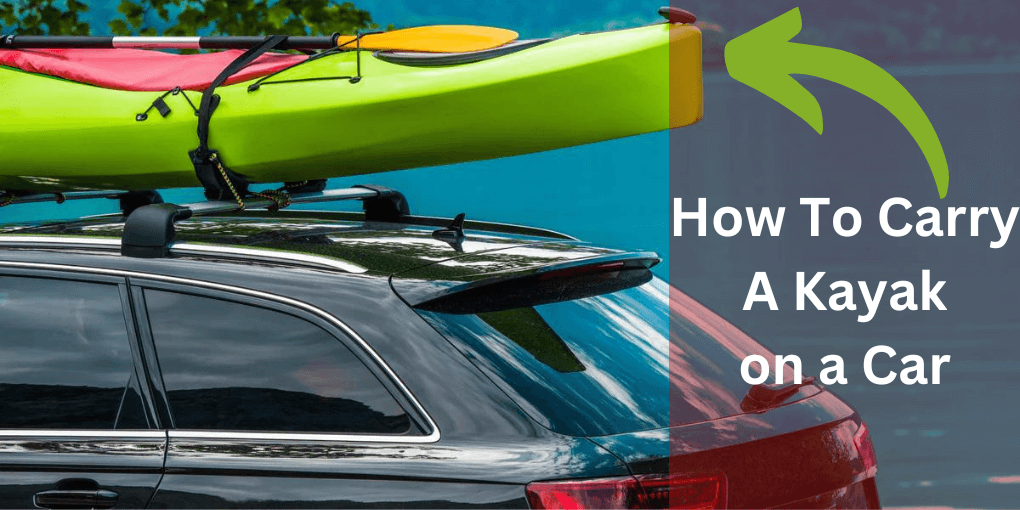Learn the Best Techniques About How To Carry A Kayak on a Car
It is important to carry a kayak safely in a car. This involves making sure the kayak is securely fastened to the car to prevent accidents or damage during transportation.

If the kayak is not properly secured, it could move or fall off while driving. This could cause accidents on the road, harm to others, and damage to the kayak or the car.
Additionally, a loose kayak may create wind resistance and drag. It can affect fuel efficiency and possibly cause the car to flip over.
Therefore, it’s crucial to know how to carry a kayak on a car securely and safely to avoid such incidents. It ensures both the kayak and the car reach their destination without any problems.
Overview of the steps to carrying a kayak on a car
Here are the steps for carrying a kayak on a car:
- Clean the kayak and the car roof to remove any dirt or debris that can scratch the car or damage the kayak.
- Place the kayak on the roof of the car and adjust it to the desired position.
- Secure the kayak to the roof of the car using straps or ropes. It ensures that it is tightly fastened and won’t move during transportation.
- Check the straps or ropes regularly during transportation to ensure that the kayak is still securely fastened.
- Use bow and stern lines to further stabilize the kayak and prevent any movement while driving.
- Drive carefully and avoid sudden movements or high speeds to prevent the kayak from coming loose or causing accidents.
- Upon arrival, carefully remove the kayak from the roof of the car and store it properly.
Choosing the right type of kayak carrier for your car
Choosing the right type of kayak carrier for your car is an important step in safely transporting your kayak.
It can be difficult to find the best carrier because there are so many various kinds available, including roof racks, J-cradles, saddles, and trailers.
Your car type, kayak size and weight, and transportation demands can assist you to choose.
It’s crucial to select a carrier that can securely and safely hold your kayak while driving without causing any damage to your car or the kayak.
Measuring your kayak and determining the best placement on the car
Measuring your kayak and determining the best placement on your car are crucial for safe transportation.
Before loading the kayak onto the car, you should measure its length, width, and height.
You need to notify that it will fit on the car roof and that there is enough clearance for any obstacles such as bridges or low-hanging branches.
The best placement of the kayak on the car will depend on its size, shape, and the type of carrier being used.
For example, a J-cradle carrier may require the kayak to be placed on its side, while a saddle carrier may require it to be placed flat.
It’s important to follow the instructions of the carrier manufacturer. You have to make sure that the kayak is balanced and centered on the car roof to avoid any potential safety issues while driving.
Loading the Kayak On Car
Loading the kayak onto the car is a critical step in safe transportation. Here are the steps involved in loading a kayak onto a car:
- Position your car in a safe and level area, away from traffic and obstacles.
- Place the carrier on the roof of the car, following the manufacturer’s instructions.
- Lift the kayak and place it onto the carrier, ensuring that it is centered and balanced.
- Secure the kayak to the carrier using straps or ropes, following the carrier’s instructions.
- Check that the kayak is tightly fastened and won’t move during transportation.
- Use bow and stern lines to further secure the kayak and prevent any movement while driving.
- Double-check that the kayak is evenly balanced and centered on the car roof.
- Close and lock all doors, and check that the kayak doesn’t interfere with any antennas or other car parts.
- Test the stability of the kayak and the carrier by gently rocking the kayak from side to side.
- Drive carefully and avoid sudden movements or high speeds to prevent the kayak from coming loose or causing accidents.
Safety Tips
When carrying a kayak on a car, there are some safety tips to keep in mind. Here are some key safety tips to follow:
- Always check that the kayak is properly secured and tightly fastened to the carrier before driving.
- Use additional straps, ropes, or bow and stern lines to further secure the kayak. It helps to prevent any movement while driving.
- Double-check that the kayak is evenly balanced and centered on the car roof. It avoids any safety hazards while driving.
- Follow the speed limits and avoid sudden movements or high speeds to prevent the kayak from coming loose or causing accidents.
- Check that the kayak and carrier don’t interfere with any antennas or other car parts before driving.
- Use caution when entering garages, drive-throughs, or other low-clearance areas to avoid damage to the kayak or the car.
- Be mindful of wind resistance and drag caused by the kayak on the car roof. It can affect fuel efficiency and driving stability.
- If you’re carrying multiple kayaks, make sure they are properly secured and balanced.
- Regularly check the straps and ropes holding the kayak to ensure they are tight and secure during transportation.
- When arriving at your destination, carefully unload the kayak from the carrier to avoid any injuries or damage to the car or the kayak.
Maintenance Tips
- Proper maintenance of your kayak carrier and your kayak is essential to ensure safe and secure transportation. Here are some maintenance tips to keep in mind:
- Check the carrier for any signs of wear and tear, rust, or damage, and repair or replace any damaged parts before using them.
- Regularly clean the carrier to remove any dirt, dust, or debris. It can cause damage or interfere with the carrier’s performance.
- Check the kayak for any signs of damage, cracks, or leaks before and after every trip. If necessary, fix or replace any damaged components.
- Store the kayak and the carrier in a dry and clean place. You should keep away from direct sunlight and extreme temperatures.
- Lubricate any moving parts of the carrier, such as locks or hinges, to ensure smooth operation and prevent rust and corrosion.
- Check the straps and ropes holding the kayak to ensure they are tight and secure during transportation.
- Use protective padding or covers to prevent any scratches or damage to the kayak.
- Follow the manufacturer’s instructions for the carrier and the kayak to ensure proper use and maintenance.
- Avoid overloading the kayak or the carrier beyond their weight limits. It can cause damage or safety hazards.
- Consider getting regular maintenance checkups for your car. Especially if you frequently transport a kayak on the car roof, to ensure it’s in good condition and can handle the extra weight and wind resistance.
Recap of the steps for safely carrying a kayak on a car
To safely carry a kayak on a car, follow these steps:
Choose the right type of kayak carrier for your car, based on the type of car. The number and size of kayaks you need to transport.
Measure your kayak and determine the best placement on your car, based on the type of carrier and the size of the car roof.
Load the kayak onto the carrier, making sure it’s centered and evenly balanced, and securely fasten it using straps or ropes.
Follow safety tips such as checking that the kayak is properly secured, avoiding sudden movements or high speeds, and regularly checking the straps and ropes during transportation.
Perform regular maintenance of the kayak carrier. The kayak includes cleaning, checking for damage, and following the manufacturer’s instructions for use and maintenance.
By following these steps, you can ensure that your kayak is safely and securely transported on your car, and avoid any accidents or damage during transportation.
Final Thought
Carrying a kayak on a car can be a convenient and enjoyable way to transport your kayak to your favorite waterways.
However, it’s important to do it safely and securely to avoid accidents, damage to your kayak or car, and harm to others.
By following the steps outlined in this guide,
- including choosing the right type of kayak carrier,
- measuring your kayak,
- loading it onto the carrier,
- following safety tips,
- and performing regular maintenance,
You can ensure that your kayak is transported safely and efficiently.
With these precautions in mind, you can enjoy your kayaking adventures with peace of mind and confidence.


